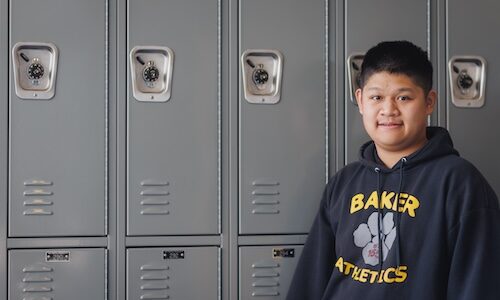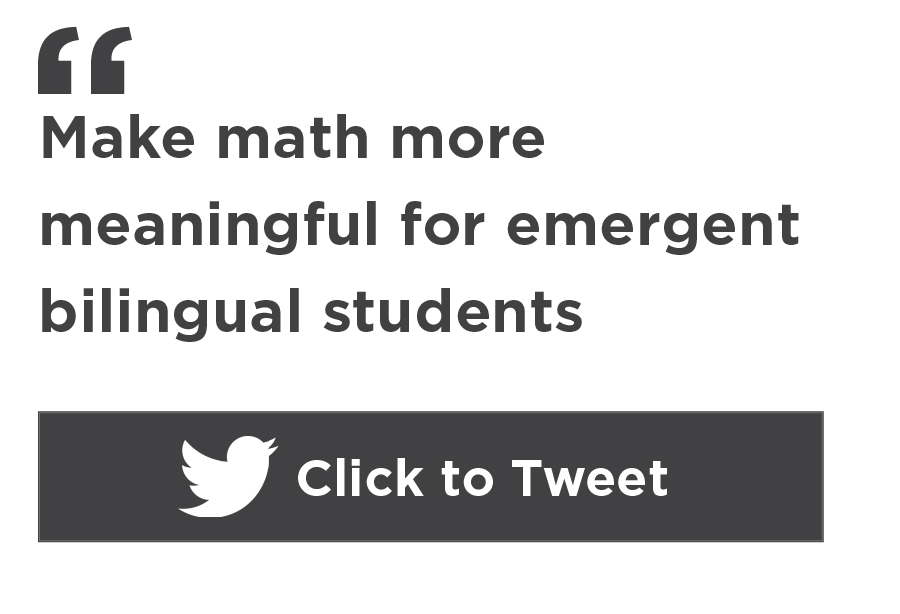
Take a peek inside an engaged math classroom with me. Imagine students doing math, instead of passively listening to how to do it. Notice them interacting with a high-quality curriculum packed with rich math tasks and grade-appropriate materials that intentionally develop problem solving and reasoning skills. See them in productive struggle when trying to make sense of problems, looking for patterns, attempting different methods, finding solutions, and communicating with peers both verbally and in writing.
Does this scenario sound familiar? If you were thinking of NCTM’s process standards, Common Core’s Standards for Mathematical Practice, or perhaps the Five Strands of Mathematical Proficiency, you are on the right pathway. Furthermore, I’ll hypothesize that you have recognized an engaged math classroom as one with a heavy emphasis on communication. We don’t always think about communication as an important part of the math classroom, but it’s critical, especially for emergent bilingual students. Let’s examine the two specific things they need from you, their math teacher, for success: opportunities to engage in meaningful mathematics and a language-rich environment with appropriate supports.
Engage in meaningful mathematics
So what is meaningful mathematics, exactly? Meaningful mathematics centers on mathematical sense making and the communication of how everything comes together in a logical way. It includes rich math tasks that allow students to move beyond engaging with math as just a series of memorized procedures that are executed without much thought.
We don’t always think about communication as an important part of the math classroom, but it’s critical, especially for emergent bilingual students.
Activities that include rich math tasks allow students to see math skills as a useful means to understand a mathematical concept, rather than a series of disconnected processes and procedures. As my colleague Ted Coe recently explained, “Ideas in mathematics build on other ideas in a logical fashion. Nothing just ‘pops up’ or stands alone.” The NRICH Project out of the University of Cambridge elaborates on the value of the deeper approach rich math tasks offer in their article “What is a mathematically rich task?”: “Rich tasks allow the learner to ‘get inside’ the mathematics,” they explain. “The resulting learning process is far more interesting, engaging and powerful; it is also far more likely to lead to a lasting assimilation of the material for use in both further mathematical study and the wider context of applications.” Yet for many students, the thread in math isn’t clear. And this disconnect, to borrow from Ted again, “is a consequence of a focus on ‘ways of doing’ mathematics while ignoring the ‘ways of thinking’ about the mathematics.”
Now that we’ve defined meaningful mathematics, let’s explore two specific ways to engage emergent bilingual students:
- Make the math relatable. It’s important to include opportunities for students to see themselves within a context or relate to the topic at hand. This can be as simple as inserting students’ names into a context or changing the context altogether, so it more closely relates to a variety of cultures. One of the strategies I found effective with my emergent bilingual students was to translate one or two key words into their native language when engaging in a new topic.
- Reduce the amount of context switching. When possible, build on context you’ve already explored with your students rather than introducing too many different details for them to understand and remember. For example, if you have a great lesson or series of lessons where each task is a new scenario, consider altering the tasks to align with a single scenario. There’s no need for you to change the actual mathematics; just standardize the context. Your emergent bilingual students will be able to engage with the math more deeply because they won’t be spending as much time trying to understand the scenario.
Provide a language-rich environment
Engaging and meaningful math tasks create opportunities for students to use language often in the math classroom, helping them to strengthen communication skills and, for kids who are learning English in particular, to practice a language that is newer to them.
All students should engage with rich math tasks, but such tasks present instructional challenges for students who are learning English. Emergent bilingual students should—and can—be held to high expectations regarding the mathematics and simultaneously receive supports with the language. Now, that is very easy to state but a little more challenging to enact. Collaboration between content and ESOL teachers plus leveraging translanguaging are two approaches to consider when making English accessible to the emergent bilingual students in your classroom. I also typically follow four research-based principles for promoting academic language put forth by Stanford University:
- Support sense making by scaffolding tasks and amplifying language, instead of simplifying it
- Provide students with abundant opportunities to communicate and refine their mathematical thinking
- Structure and support productive mathematical conversations in a variety of formats
- Provide intentional opportunities for students to be aware of their own mathematical thinking and how they use language to communicate it
Including rich math tasks and utilizing these four principles for classroom instruction will assist in elevating the success of emergent bilingual students in their study of mathematics.
An example
Let’s look at a simple task from Illustrative Mathematics to demonstrate how meaningful math and language come together in the classroom to deeply engage students in learning. It’s lesson 2.3 for seventh grade and is called “Making Bread Dough.” With this example, you’ll be able to see how each mathematics principle is driven by your actions during planning and instruction.

The first thing to note is that this task has enough text to potentially make it challenging for English learners. To scaffold instruction for them, I encourage you to use the language strategy Three Reads. It’s a great way to help students make sense of the context of a math problem and understand what they are being asked to do before they get started. With this strategy, you’ll read the math problem three times. The first read is for students to understand the context of the situation. During the second read, you’ll ask students to identify quantities they feel are important to the context. And, finally, in the third read, you’ll support your students in brainstorming solutions by thinking of different approaches to solving the problem. This third read provides an excellent opportunity for students to reflect on their ways of thinking and their peers’ ways of thinking, too. This makes students more aware of thinking processes, how they communicate mathematically, and the reality that there are often many ways to tackle a math problem. Not only does the Three Reads provide appropriate scaffolding, but it also intentionally promotes discourse.
Mathematical discourse is an essential component in any math classroom, and one that requires careful planning because of the interconnectivity of the mathematics, academic language, and communication. One of the biggest challenges I had as a math teacher was understanding how to effectively include English learners because I knew they would benefit from participating in the discussion as well as listening to it. I found the key was to identify the conversation supports that matched the task and the language demands. For tasks like “Making Bread Dough,” I often had students share their thinking with a partner first and then used a sequence of student work samples to facilitate discussions between students. When necessary, I added sentence frames, and sometimes modeled them, to support the proportional-relationships part of the conversation. Some examples include “_______ times as many as _______” or “_______ for every _______ of _______.” This small addition would often be enough support to encourage English learners to voluntarily participate in the discourse.
Emergent bilingual students should—and can—be held to high expectations regarding the mathematics and simultaneously receive supports with the language.
There are several cultural and language considerations for this task as well. One way to invite students into the task is to ask them questions about their experience with baking bread and perhaps how bread is served in their culture. You can use visuals, like measuring cups and spoons, along with gestures while you demonstrate how to measure the ingredients. A linguistic consideration is recognizing that the word “table” has many different meanings by using visual examples for a table as a piece of furniture and as a graphic representation. In addition, it may be beneficial to point out the rows and columns in a table because this terminology could surface within the discussions.
Tying it all together with intention
As emergent bilingual students work to make sense of the mathematics, it is important to ensure they do not struggle with the associated academic language. When lessons have explicit goals for language, be sure to make your communication expectations of students clear and that you build your lessons with those goals as a guide. Take a look at the learning goals for the dough-making task below as an example. Notice the language goals in parentheses. When designing my lesson, I would focus on reminding myself that I must provide students the opportunity to speak and write about the proportional relationships if I want them to be successful.

The good news is that if the materials you use do not contain supports for your emergent bilingual students, you can make slight modifications and additions by keeping the four guiding principles I mentioned earlier in mind. I usually start by analyzing the mathematical tasks for language demands and then determining the necessary supports to meet those demands. Ask yourself some important questions: What are the language goals of this lesson? How will I provide students the opportunity to communicate their mathematical thinking (writing, speaking, listening, representing)? What support will students need to communicate effectively? How will they refine thinking? As you work through the answers to these questions in planning for instruction, the lesson will evolve and engaged emergent bilingual students in your classroom will flourish.








